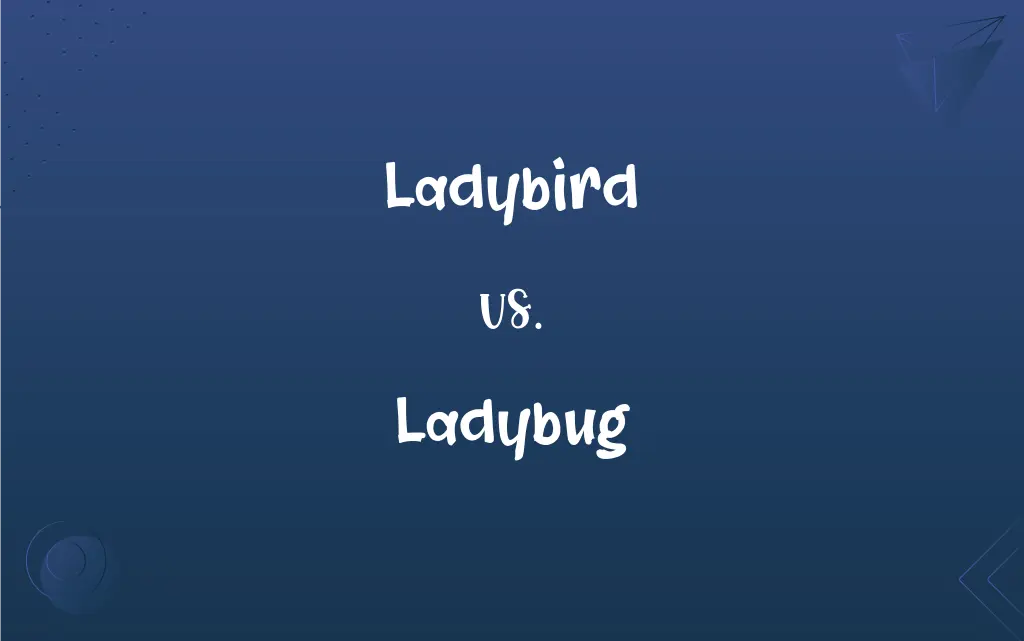Ladybird vs. Ladybug: What's the Difference?
Edited by Harlon Moss || By Janet White || Updated on June 13, 2024
Ladybird and Ladybug refer to the same insect; "Ladybird" is primarily British English, while "Ladybug" is American English.

Key Differences
Ladybird and Ladybug essentially refer to the same small beetle characterized by a round, often spotted shell, typically red, orange, or yellow. The distinction between these two terms is primarily regional. "Ladybird" is predominantly used in British English, while "Ladybug" is the preferred term in American English. Both words describe a variety of beetles belonging to the Coccinellidae family, recognized for their role in controlling pest populations, as they consume aphids and other plant-eating pests.
Ladybirds, or ladybugs, are appreciated not only for their functionality in maintaining ecological balance but also for their distinctive, colorful appearance. They are often associated with good luck and are a common subject in cultural and children's stories. The fascination with these beetles extends beyond their physical attributes, encompassing their utility in agricultural settings, where they are instrumental in mitigating the proliferation of harmful insects.
Both terms, "Ladybird" and "Ladybug," are grammatically treated as nouns. They serve as subjects or objects within sentences and do not change in form based on American or British usage. Whether one is saying "I saw a ladybird in the garden" or "I saw a ladybug in the garden," the grammatical usage is consistent, with the variation only in the lexical choice depending on the regional preference.
The names "Ladybird" and "Ladybug" are said to have religious origins, with "lady" referring to the Virgin Mary. The red color of the beetle’s shell is said to represent Mary's cloak, and the black spots are said to symbolize her sorrows. Despite the difference in nomenclature, the cultural and ecological significance of the ladybird or ladybug remains uniform across different regions and dialects.
In conclusion, the primary difference between "Ladybird" and "Ladybug" is the regional preference in terminology. Regardless of the term used, the reference is to the same beneficial and symbolically rich insect, revered for its ecological importance and its place in cultural narratives.
ADVERTISEMENT
Comparison Chart
Definition
A small beetle, typically colorful
A small colorful beetle
Region of Usage
Predominantly British English
Predominantly American English
Grammatical Role
Used as a Noun
Used as a Noun
Contextual Appearance
Appears in British literature and conversation
Appears in American literature and conversation
Variants
No change in form across regions
No change in form across regions
ADVERTISEMENT
Ladybird and Ladybug Definitions
Ladybird
A small, round beetle, often red with black spots.
The ladybird landed gracefully on the blooming flower.
Ladybug
A beneficial insect to gardeners and farmers.
Ladybugs are valued by gardeners for their role in pest control.
Ladybird
An insect beneficial to agriculture by preying on pests.
The farmer was pleased to see ladybirds in his crops, controlling the aphid population.
Ladybug
A small, usually red or orange beetle with black spots.
A ladybug crawled on the leaf, searching for aphids.
Ladybird
A commonly depicted insect in children's books and stories.
The children's story featured a ladybird as the main character.
Ladybug
A cultural symbol of good fortune and prosperity.
Many believe that a ladybug landing on you brings good luck.
Ladybird
A symbol of luck and goodwill.
Seeing a ladybird is considered good luck.
Ladybug
A member of the Coccinellidae family of beetles.
Ladybugs are one of the many species in the Coccinellidae family.
Ladybird
A beetle belonging to the Coccinellidae family.
The Coccinellidae family includes several species of ladybirds.
Ladybug
A frequent character in folklore and children’s literature.
The ladybug is often anthropomorphized in children’s literature.
Ladybird
See ladybug.
Ladybug
Any of numerous small, rounded, usually colorful beetles of the family Coccinellidae, often reddish with black spots and feeding primarily on other insects, including pests such as scale insects and aphids. Also called lady beetle, ladybird.
Ladybird
Any of the Coccinellidae family of beetles, typically having a round shape and red or yellow spotted elytra.
Ladybug
(North America) ladybird.
Ladybird
Any one of numerous species of small beetles of the genus Coccinella and allied genera (family Coccinellidæ); - called also ladybug, ladyclock, lady cow, lady fly, ladybeetle, and lady beetle. Coccinella seplempunctata in one of the common European species. See Coccinella.
Ladybug
Same as Ladybird.
Ladybird
Small round bright-colored and spotted beetle that usually feeds on aphids and other insect pests
Ladybug
Small round bright-colored and spotted beetle that usually feeds on aphids and other insect pests
FAQs
Is ladybird British English and ladybug American English?
Yes, "ladybird" is predominantly used in British English, while "ladybug" is the preferred term in American English.
Do both terms refer to beetles?
Yes, both ladybirds and ladybugs belong to the beetle family Coccinellidae.
Are ladybird and ladybug the same insect?
Yes, they are the same insect, known as Coccinellidae, with the difference in name due to regional language preferences.
Are ladybirds/ladybugs beneficial to agriculture?
Absolutely, they are known to control pest populations, particularly aphids, and are thus beneficial to agriculture.
Are ladybirds/ladybugs always red with black spots?
While they are commonly red with black spots, they can also be yellow, orange, or even black, often with varying numbers of spots.
Are ladybirds/ladybugs found worldwide?
Yes, species of ladybirds/ladybugs are found worldwide, with variations in appearance and size.
Can ladybird/ladybug be used interchangeably?
While the terms can be understood interchangeably, the preference for one over the other often depends on the regional dialect.
Do ladybirds/ladybugs hibernate during winter?
Many species do hibernate during colder months, often in groups, and emerge during spring.
Do ladybirds/ladybugs have religious significance?
Yes, the "lady" in their name is said to refer to the Virgin Mary, and they have religious significance in some cultures.
Are ladybirds/ladybugs depicted in children’s literature?
Yes, they are a common subject in children’s books and are often depicted as friendly and helpful characters.
Are ladybirds/ladybugs common in gardens?
Yes, gardens are a common habitat, providing ample food resources and suitable environments.
Are ladybirds/ladybugs used in biological control of pests?
Yes, they are valued in biological control strategies due to their consumption of plant-eating pests.
Are ladybirds and ladybugs symbols of good luck?
In many cultures, yes. They are often associated with good luck, prosperity, and goodwill.
Do ladybirds and ladybugs primarily feed on aphids?
Aphids are a primary food source, but they also consume other soft-bodied insects.
Can the color of ladybirds/ladybugs vary?
Absolutely, they can be found in various colors, including red, yellow, and orange, often with different spot patterns.
About Author
Written by
Janet WhiteJanet White has been an esteemed writer and blogger for Difference Wiki. Holding a Master's degree in Science and Medical Journalism from the prestigious Boston University, she has consistently demonstrated her expertise and passion for her field. When she's not immersed in her work, Janet relishes her time exercising, delving into a good book, and cherishing moments with friends and family.
Edited by
Harlon MossHarlon is a seasoned quality moderator and accomplished content writer for Difference Wiki. An alumnus of the prestigious University of California, he earned his degree in Computer Science. Leveraging his academic background, Harlon brings a meticulous and informed perspective to his work, ensuring content accuracy and excellence.































































